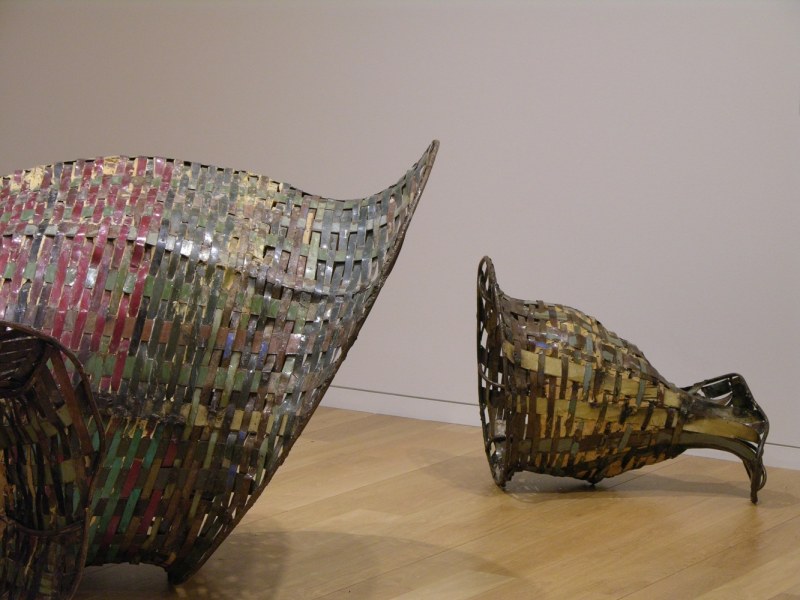
Installation artist Ranjani Shettar, 34, stands confident below the bronze shapes that cast shadows on her slim build. The multipiece sculpture that forms an eclipse-like arch covering the entire wall behind her is titled Aureole, literally, a circle of light that surrounds someone represented as holy in a painting. She walks under the pastel green forms that she took days to drill and fit into the wall, her hair messy with the rigorous work. "Don't be misled by their seeming frailness," she says with a mischievous smile, "each one of these pieces is really heavy."
Living with her artist husband Srinivas Prasad between her studios in Bangalore and in the serene Karnataka town of Sagara, Shettar is indeed going places. She has just finished setting up her work for an exhibition titled On Line: Drawing Through the Twentieth Century at the prestigious Museum of Modern Art (MoMA) in New York. Now working on one of her rare exhibitions in India, she is busy putting up her large installations at the Talwar Art Gallery in New Delhi. These installations use both conventional sculpture material such as bronze, wood, and steel and material which hasn't been traditionally used for sculpture such as beeswax, muslin, thread, and even tamarind kernel powder paste.
Born into a family of engineers in Bangalore, she was well on her way to embrace science as her career. However, diving headlong into it in her first year at college made Shettar realize how she longed to be involved with art. "I always wanted to do something which didn't feel like a job," she says. Despite coming from a background that did not intersect with art on any plane, her parents always wanted her to be an artist. Even though they knew nothing about contemporary art, their curiosity about art was evident. Not only did they make it a point to catch up on art exhibitions whenever they visited Bangalore, but they also encouraged their daughter who started painting as a three-year-old. It was only natural then that they never opposed her when she chose to study and graduate in the art of sculpture from Karnataka Chitrakala Parishath, Bangalore, which was established in 1964 by M.S Nanjunda Rao with the aim to popularise art.
Her childhood was spent in small towns in Karnataka due to her government and nourished her art as it navigated between the two words, rural and urban. She grew up close to people who used their hands instead of machines to make things. "The journey between different layers of the society is effortless for me and gives a different perspective each time that I move from one to another," she says. Influences as small as how the carpenter uses his tool or how the musical notes go in a tune have often inspired her art. Her minimalistic conception of space gives her work its distinct quality. "Even though my knowledge of music isn't that deep, I know when I'm creating a piece that the space is the pause, the taal in music," she says.
Her work is a testimony to the need she feels for change, having grown up in situations where she was always moving to new places and people. "Now change is the only constant for me, be it life or work," she says. "It never bothers me." Not sticking to any one theme, form, idea or material, her work is almost always independent of the baggage of a label. To constantly move on to new ideas, one needs to be inspired at regular intervals. For Shettar, the source of her inspiration varies continuously. "One isn't always in the same state of mind," she says, "Sometimes this state is that of joy, and at others it can be anything else. Sometimes it is also political since all of us have opinions." She then goes on to talk about her now-famous work Me, no, not me, buy me, eat me. wear me, have me, no, not me. "That work has a socialist side to it," she says. She used junked car bodies to weave their individual stories into a story, told through the form of baskets she created out of the junk. Through these stories, she addressed the issue of consumerism where excess leads to junking. The project was made in India, but the idea struck her while at a junkyard in Sharjah during a research visit. "There I realised that an object doesn't die too easily, it lives through several lives before it's junked. Junking on a massive scale is still new concept in India: we Indians have recycled stuff without being conscious of it, not due to awareness but due to necessity," she stays.
Now as she gears to put up solo exhibitions at the National Art Gallery of Victoria in Melbourne, Australia, and at the Hermes Foundation in Singapore, expectations from her mount. Yet, she is calm. There will always be fresh challenges. I'm prepared for them," she says.
-Parul